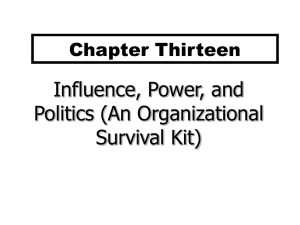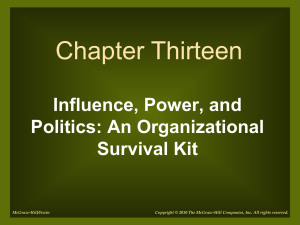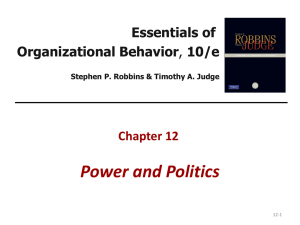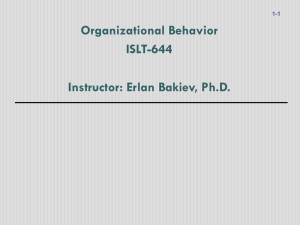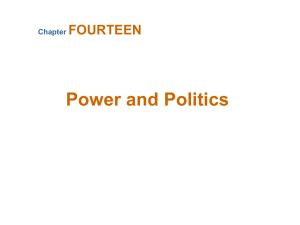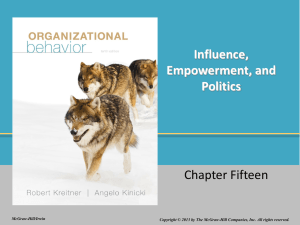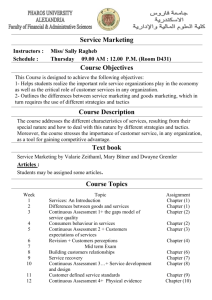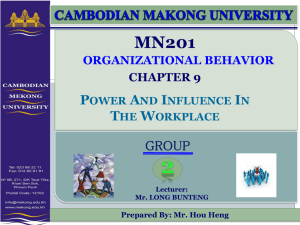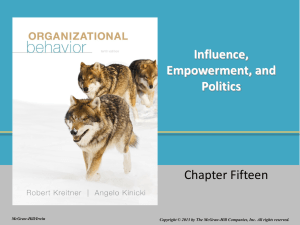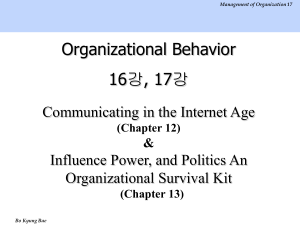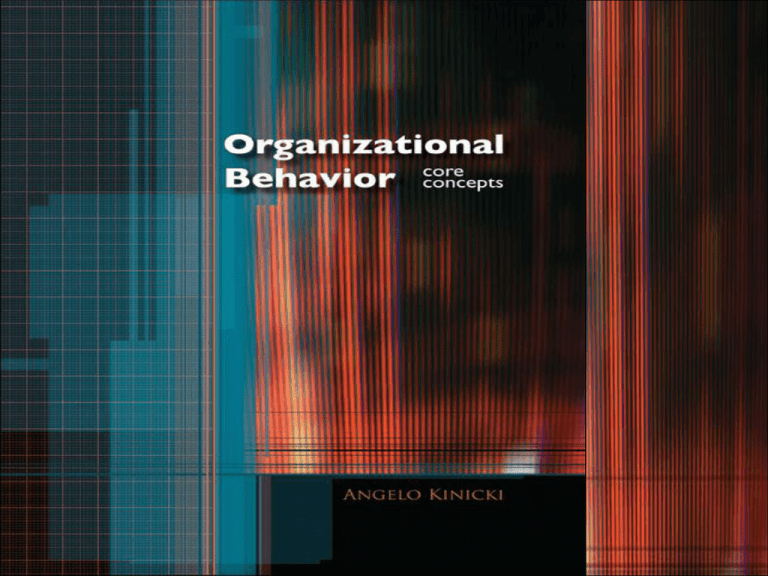
Organizational Behavior
10
core concepts
Power and Politics: How
People Influence One
Another
10-2
McGraw-Hill/Irwin
Organizational Behavior, Core Concepts
Copyright © 2008 by the McGraw-Hill Companies, Inc. All rights reserved.
Learning Objectives
• List influence tactics and outcomes, and
summarize research conclusions about
the effectiveness of the tactics
• Describe five bases of power, and give
examples of how they are related to work
outcomes
• Discuss how to make employee
empowerment succeed
10-3
Learning Objectives
• Define organizational politics, explain
what triggers it, and describe its use in
organizations
• Distinguish between favorable and
unfavorable impression management
tactics
• Explain how to manage organizational
politics
10-4
Generic Influence Tactics
10-5
1.
2.
3.
4.
5.
6.
7.
8.
9.
Rational persuasion
Inspirational appeals
Consultation
Ingratiation
Personal appeals
Exchange
Coalition tactics
Pressure
Legitimating tactics
Three Influence Outcomes
1. Commitment – substantial agreement
followed by initiative and persistence in
pursuit of common goals
2. Compliance – reluctant agreement
requiring subsequent prodding to satisfy
minimum requirements
3. Resistance – stalling, unproductive
arguing, or outright rejection
10-6
Practical Research Insights
• Commitment is more likely when people
rely on strong rational persuasion and do
not rely on pressure and coalition tactics
• Ingratiation (making the boss feel good)
can slightly improve your performance
appraisal results
10-7
Practical Research Insights
• Commitment is more likely when the
influence attempt involves something
important and enjoyable
• Credible people tend to be the most
persuasive
• Unfair influence tactics were associated
with greater resistance among
employees
10-8
Creating Strategic Allies
•
•
•
•
10-9
Mutual respect
Openness
Trust
Mutual benefit
How to Do a Better Job of Influencing
and Persuading Others
• Reciprocity
– almost universal belief that people should be
paid back for what they do – that one good
turn deserves another
10-10
Social Power and Empowerment
• Social power
– ability to marshal the human, informational,
and material resources to get something
done
10-11
Question?
Which type of power obtains compliance
through formal authority?
A. Reward
B. Coercive
C. Legitimate
D. Referent
10-12
Five Bases of Power
• Reward power
– obtaining compliance with promised or
actual rewards.
• Coercive power
– obtaining compliance through threatened or
actual punishment.
• Legitimate power
10-13
– obtaining compliance through formal
authority.
Five Bases of Power
• Expert power
– obtaining compliance through one’s
knowledge or information.
• Referent power
– obtaining compliance through charisma or
personal attraction.
Read an article on
organizational power
10-14
Employee Empowerment
• Empowerment
– sharing varying degrees of power with lowerlevel employees to better serve the
customer
10-15
Randolph’s Empowerment Model
Figure 10-1
10-16
Domain of Organizational Politics
• Organizational politics
– intentional acts of influence to enhance or
protect the self-interests of individuals or
groups
10-17
Sources of Uncertainty
1.
2.
3.
4.
5.
10-18
Unclear objectives
Vague performance measures
Ill-defined decision processes
Strong individual or group competition
Any type of change
Levels of Political Action in
Organizations
Figure 10-2
10-19
Question?
What is a temporary groupings of people
who actively pursue a single issue?
A. Alliance
B. Coalition
C. Association
D. Federation
10-20
Levels of Political Action
• Coalition
– temporary groupings of people who actively
pursue a single issue
10-21
Political Tactics
•
•
•
•
•
•
•
•
10-22
Attacking or blaming others
Using information as a political tool
Creating a favorable image
Developing a base of support
Praising others
Forming power coalitions with strong allies
Associating with influential people
Creating obligations
Impression Management
• Impression management
– process by which people attempt to control
or manipulate the reactions of others to
images of themselves or their ideas
10-23
Favorable Impression
Management
• Job-focused
– manipulating information about one’s
performance
• Supervisor-focused
– praising and doing favors for one’s
supervisor
• Self-focused
10-24
– presenting oneself as a polite and nice
person
Bad Impressions
Four motives for intentionally looking bad
at work:
• Avoidance
• Obtain concrete rewards
• Exit
• Power
10-25
Bad Impressions
Five unfavorable upward impression
management tactics:
• Decreasing performance
• Not working to potential
• Withdrawing
• Displaying a bad attitude
• Broadcasting limitations
10-26
How to Keep Organizational Politics
within Reasonable Bounds
• Screen out overly political individuals at hiring
time.
• Create an open-book management system.
• Make sure every employee knows how the
business works and has a personal line of sight
to key results with corresponding measurable
objectives for individual accountability.
10-27
How to Keep Organizational Politics
within Reasonable Bounds
• Have non-financial people interpret periodic
financial and accounting statements for all
employees.
• Establish formal conflict resolution and
grievance processes.
• As an ethics filter, do only what you feel
comfortable doing on national television.
• Publicly recognize and reward people who get
real results without political games.
10-28

